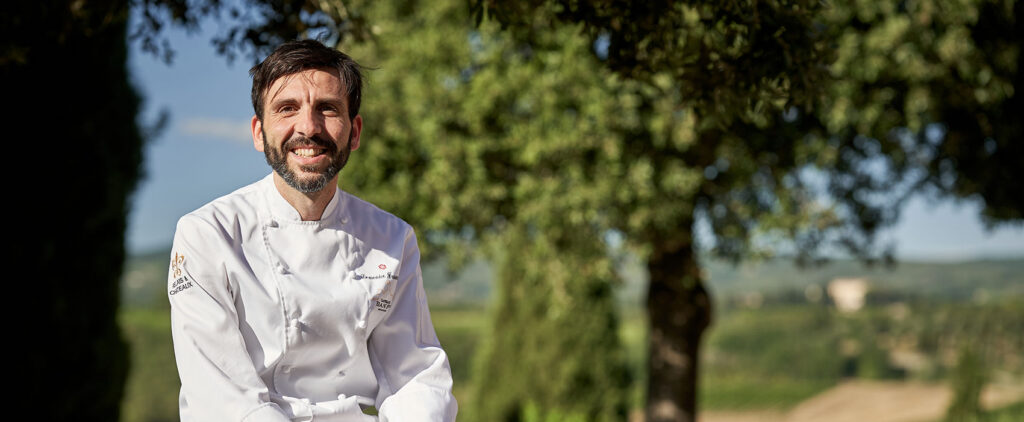Tuscany and wine tourism: discover all the secrets of the quintessential combination of Italian tourism on the Castello Banfi Wine Resort blog.
Wine tourism in Tuscany: what to know
Oenotourism, a valuable combination of culture and wine tasting, is a sensory experience of rare beauty, to be lived in places rich in charm and attraction, not only for the richness of their soils, but also for the artistic, cultural and landscape treasures they contain. Wine tourism in Italy, and in Tuscany in particular, a region that is home to renowned vines and millennial traditions, finds one of its greatest expressions. In fact, wine tourism in Tuscany offers the opportunity to immerse oneself in the wine culture, to taste fine wines and to embrace the authenticity of a millenary tradition, offering an unforgettable journey.
Tuscany and wine tourism are a combination that symbolizes Italian excellence in the tourism sector. According to the latest data, approximately 14 million visitors travel each year to the green hills and lush vineyards of this region to visit historic wineries, where the art of winemaking blends with the beauty of the landscape, and to enjoy a few days of relaxation surrounded by nature in charming villages and wine resorts, such as Castello Banfi Wine Resort near Poggio alle Mura.
Wine tourism in Tuscany: the data
But let's take a closer look at the data on wine tourism in Tuscany. According to the latest Coldiretti/Ixè report, wine tourism in Italy is a phenomenon that involves 58% of Italians: good food and good wine are in fact some of the main reasons why a city is chosen as a tourist destination for 56% of those interviewed. In the case of Tuscany, where food and wine tourism blends with art and nature tourism, the numbers are even more positive.
Wine tourism in Tuscany is now so well established that it is one of the most attractive destinations in Italy. In terms of wine tourism, this region ranks third, after Piedmont and Campania (according to Isnart data for Enit), for its presence in “food and wine” tourist packages. According to data on wine tourism in Tuscany in 2022, compiled by the Regional Statistics Office, there were over 13 million tourists and more than 42.7 million overnight stays, a significant increase compared to 2021.
The great success of wine tourism in Tuscany can also be seen on social channels: visits to wine tourism offer pages grew from March 2021 to February 2022 by 136.29%.
Moreover, wine tourism in Tuscany fuels not only the tourism sector but also the production sector, with a considerable turnover. According to the latest estimates of the Ismea-Qualivita Observatory, the PDO-PGI wine sector in Tuscany is worth 1004 million euro (86.9% of the country's total certified production). This is according to Roberta Garibaldi, vice-president of the Ocs Tourism Committee, one of the leading experts in wine tourism in Tuscany and Italy.
Tuscany and wine tourism: an ancient history
Tuscany's primacy in the wine tourism sector is long-standing. In fact, it was this region that gave birth to wine tourism in Italy, thanks to the Cantine Aperte (Open Cellars) and Calici sotto le stelle (Goblets under the Stars) initiatives in 1993, as well as the Movimento Turismo del Vino (Wine Tourism Movement).
However, wine tourism guidelines were only formalized in the 2000s, with the creation of “wine routes,”i.e., protected routes that promote places and products, and it was only in 2019 that the so-called Wine Tourism Decreewas issued, which regulates winery visits, the invoicing of wine tourism-related activities, staff skills, and guidelines on the minimum quality requirements and standards for the practice of wine tourism.
Law on Wine Tourism in Tuscany
Although the decree is valid throughout Italy, some regions are further fine-tuning their legislation on the subject to better protect and enhance this form of tourism, and Tuscany is among them. The law on wine tourism in Tuscany in fact saw a development in the spring of last year with Regional Law no. 15 of 24 May 2022 (Disciplina dell'oleoturismo e dell'ospitalità agrituristica. Amendments to Regional Law 30/2003).
It regulates wine tourism in Tuscany with regard to:
property intended for agritourism;
organisation of promotional events for traditional or quality company products;
wine and oil tourism activities and requirements for their performance;
minimum quality standards to be met.
New definition of wine tourism
Of particular interest is the new definition of wine tourism , which we quote in full: "Wine tourism and olive oil tourism refer to all activities related to learning about wine and extra virgin olive oil, respectively, carried out at the place of production, visits to places where grapes and olives are grown, produced, or where tools used in the cultivation of vines and olive trees are displayed, the tasting and marketing of the company's wine and oil products, also in combination with food, and educational and recreational initiatives in wineries and vineyards, oil mills, and olive groves."
The enactment of a law on wine tourism in Tuscany is of fundamental importance, serving as a bulwark for the protection of local producers and support for their valuable wine-making activities. This measure guarantees a solid regulatory framework capable of preserving centuries-old traditions and stimulating excellence in the sector. At the same time, this law becomes a tool for protecting visitors, ensuring standards of safety, quality, and authenticity in the experiences offered . In this way, the promotion of the wine heritage is combined with a conscious and rewarding welcome for all those who choose wine tourism in Tuscany as a form of travel and discovery.


